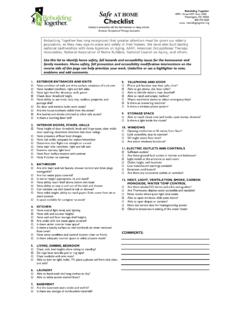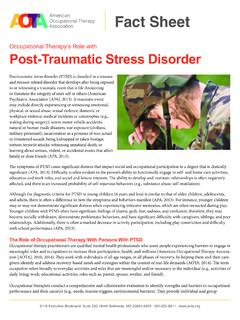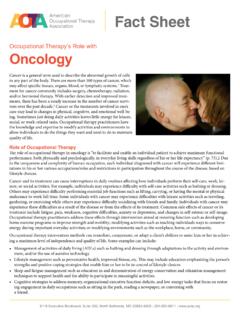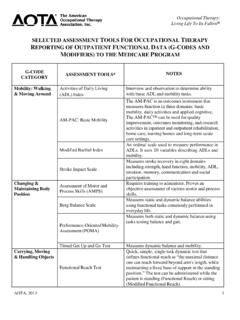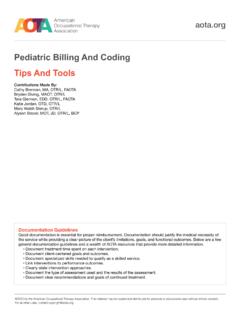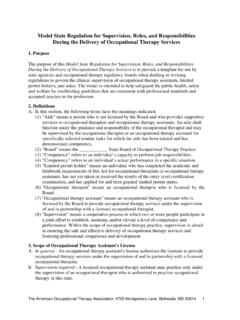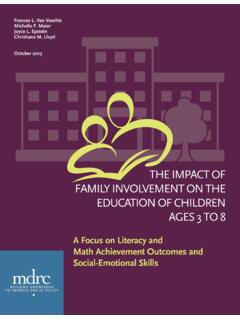Transcription of Occupational Therapy’s Role with Children and Youth
1 Occupational therapy practitioners work with Children , Youth , and their families, caregivers, and teachers to pro-mote active participation in activities or occupations that are meaningful to them. Occupation refers to activities that support the health, well-being, and development of an individual ( american Occupational therapy Asso-ciation, 2014). For Children and Youth , occupations are activities that enable them to learn and develop life skills ( , preschool and school activities), be creative and/or derive enjoyment ( , play), and thrive ( , self-care and relationships with others) as both a means and an end. Occupational therapy practitioners work with Children of all ages and abilities through the habilitation and rehabilitation process. Recommended interventions are based on a thorough understanding of typical development, the environments in which Children engage ( , home, school, playground) and the impact of disability, illness, and impairment on the individual child s development, play, learn-ing, and overall Occupational therapy practitioners collaborate with parents/caregivers and other professionals to identify and meet the needs of Children experiencing delays or challenges in development; identifying and modifying or compensating for barri-ers that interfere with, restrict, or inhibit functional performance; teaching and modeling skills and strategies to Children , their families, and other adults in their environments to extend therapeutic intervention to all aspects of daily life tasks.
2 And adapting activities, materials, and environmental conditions so Children can participate under different conditions and in various settings ( , home, school, sports, community programs). Developmental NeedsThe primary occupations of infants, toddlers, and young Children are playing, learning, and interacting with caregivers and, eventually, their peers. Occupational therapy interventions address developmental milestones such as (but not limited to), facilitating movement to sit, crawl, or walk independently; learning to pay attention and follow simple instructions; de-veloping the ability to eat, drink, wash, and dress independently; learning to cope with disappointment or failure; reducing extraneous environmental stimuli, such as noise for a child who is easily distracted; building skills for sharing, taking turns, and playing with peers; using toys and materials in both traditional and creative ways; and participating in age appropriate daily routines.
3 The primary occupations of older Children and teens are integrating educational instruction in and outside of school, form-ing and maintaining productive friendships, and beginning the transition to work and more independent, higher educa-tion. Occupational therapy interventions for this population often expand to include such items as adapting or modifying curricula, the environment, or activities to support participation in educational routines and learning activities; navigating more complex social relationships, including dating; assessing the skills needed to learn to drive or assisting with alterna- Occupational therapy s Role with Children and YouthFact Sheet6116 Executive Boulevard, Suite 200, North Bethesda, MD 20852-4929 | 301-652-6611 | by Dottie Handley More, MS, OTR/L, and the Early Intervention & School Special Interest Section Standing Committee for the american Occupational therapy Association.
4 Copyright 2015 by the american Occupational therapy Association. This material may be copied and distributed for personal or educational uses without written consent. For all other uses, contact therapy enables people of all ages live life to its fullest by helping them to promote health, make lifestyle or environmental changes, and prevent or live better with injury, illness, or disability. By looking at the whole picture a client s psychological, physical, emotional, and social make-up Occupational therapy assists people to achieve their goals, function at the highest possible level, maintain or rebuild their independence, and participate in the everyday activities of community mobility options; strengthening self-determination and decision making skills, and enhancing overall independence; helping with vocational planning and transitions, including employer supports.
5 And planning for transition to college, including time management, study habits and routines, and independent living NeedsOccupational therapy practitioners work with students in preschool, and elementary, middle, and high school to sup-port successful learning, appropriate behavior, and participation in daily routines and activities. Services can be provided under the federal Individuals with Disabilities Education Improvement Act (IDEA), Section 504 of the Rehabilitation Act, or the Americans with Disabilities Act for students with disabilities, or as part of a multi-tiered problem-solving process for general education students ( , Tier Interventions, early intervening services). Practitioners also support Children as they transition throughout the school environments, such as from preschool to kindergarten, from elementary to middle school, and from high school to college and adult life.
6 Injury Related Needs When a child experiences a serious illness or injury, medically based or rehabilitative Occupational therapy services may be provided. These services are developmentally appropriate and may emphasize physical skills to increase movement, strength, and/or coordination; and adaptive skills or equipment to address deficits in cognitive and executive function, sensory processing, visual motor and perception, and the ability to form appropriate social and interpersonal relationships, with a goal of improving the child s functional performance and independence. Outpatient services may be provided to continue the rehabilitation progress. Emotional Behavioral Needs Occupational therapy practitioners have training in psychosocial and mental health conditions and are well suited to ad-dress Children s emotional and behavioral needs as they relate to everyday activities and social interactions.
7 For example, Occupational therapy practitioners help Children develop the ability to cope with challenges, and to use calming strategies to deal with frustration, defuse anger, and manage impulsivity in order to succeed at individual tasks and collaborative interactions at home, at school, and in the community. As Children grow older, skills for success in independent living become essential. Occupational therapy practitioners ad-dress self-determination and self-advocacy skills, along with the transition into adult Active participation of caregivers and families in their Children s lives is crucial to helping them achieve their greatest potential. If they are concerned about their child s development and/or functional performance abilities, caregivers can consult their physician, local health clinic, hospital outpatient clinic, or educational service district to request an occupa-tional therapy Occupational therapy Association.
8 (2014). Occupational therapy practice framework: Domain & process (3rd ed.). american Journal of Occupa-tional therapy , 68(Suppl. 1), S1 S48.
